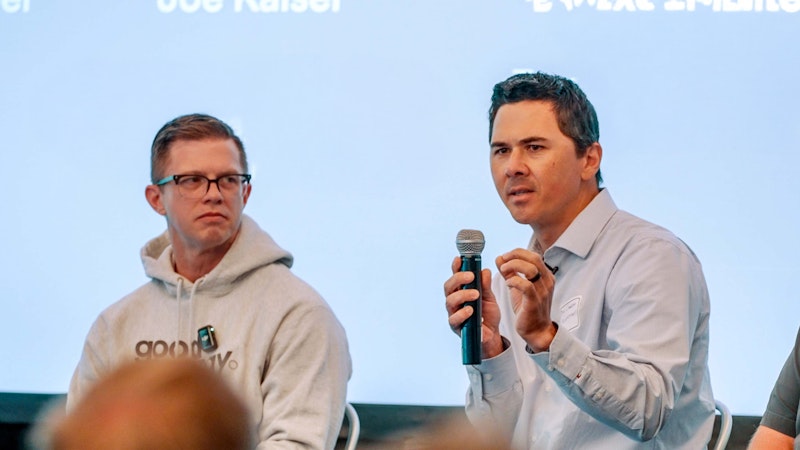Torus CEO Nate Walkingshaw shares his thoughts on the current state of our electrical grid and how new energy technology can power our lives more reliably and affordably.
I have spent a large portion of my career breaking apart monolithic systems and transforming them into reliable, scalable, and secure distributed architectures.
Through frameworks like Directed Discovery, I have guided numerous fortune 50/100/500 organizations in building human-centered teams that create modern software + firmware platforms capable of continuous discovery and delivery. This approach ensures that these companies software platforms and hardware products can keep up with the pace of change. As most of us know a market pace doesn’t give two rips about our product. It is the job of the creator and company to build and iterate to match the needs of an ever changing market.
When we look back at the history of software architecture, we see a familiar market pattern: the rise and fall of the monolith. In the early days, monolithic applications were the backbone of software systems. They were simple, all-in-one solutions that handled everything from data management to user interface in a single, cohesive unit. This simplicity was their greatest strength — and ultimately, their greatest weakness.
Monolithic applications were valuable because they provided a straightforward approach to building and maintaining software. Everything was in one place, making it easy to understand, develop, and deploy. For small teams and simple applications, this was ideal. The initial investment in creating a monolith paid off quickly because changes could be made directly and deployed rapidly without worrying about the complex interactions of a distributed system.
Example of a Monolithic Web Application
Imagine a traditional e-commerce website where all functionalities — user authentication, product catalog, shopping cart, payment processing, and order management — are bundled into a single codebase. This approach works well initially, providing a seamless experience for developers to add features and fix bugs. However, as the site grows, any modification or update risks affecting the entire application. Scaling becomes difficult; a spike in user activity during a sale could overwhelm the system, leading to slowdowns or crashes.
However, as applications grew in size and complexity, the limitations of the monolithic architecture became apparent. Large monolithic applications were difficult to scale and maintain. A single bug could bring down the entire system, and deploying updates became a massive undertaking. The need for flexibility and resilience in the face of growing demands led to the evolution of distributed systems — a network of loosely coupled services that could scale independently and provide robustness against failures.
Example of a Distributed Web Application
Now, consider a modern e-commerce platform built with a microservices architecture. Each functionality — user service, product service, cart service, payment service, and order service — is developed, deployed, and scaled independently. If the product catalog needs to handle more traffic, only that service is scaled up without affecting the others. If a bug is found in the payment service, it can be fixed and redeployed without bringing down the entire site. This modular approach increases flexibility, resilience, and scalability.
This evolution mirrors what’s happening today in the energy sector, particularly with the advent of distributed energy storage and management systems. Initially, our energy grid operated much like a monolithic application. Centralized power plants generated electricity, which was then distributed across the grid to consumers. This model worked well for a time, providing a reliable and straightforward way to manage energy production and distribution.
Centralized power plants were valuable for the same reasons monolithic applications were: simplicity and control. A single entity managed the generation of power, ensuring consistency and reliability. However, as our energy needs have grown and diversified, the limitations of this centralized approach have become more evident.
Example of a Centralized Grid
Think of a large coal-fired power plant supplying electricity to an entire city. This single point of generation is relatively easy to manage and maintain, and it ensures a consistent power supply. However, if the plant experiences a failure, the entire city could be left without power. Scaling up to meet increased demand involves building more power plants, which is costly and time-consuming.
The modern energy landscape demands flexibility, resilience, and efficiency — qualities that centralized grids struggle to provide. Just as the software industry shifted towards distributed architectures, the energy sector is now embracing distributed energy storage and management systems.
Example of a Distributed Grid
Consider a smart grid powered by numerous small-scale energy sources like rooftop solar panels, wind turbines, and local battery storage units. Each neighborhood generates and stores its own energy, reducing dependency on a central source. If one component fails, others continue to operate, ensuring continuous power supply. This grid is more efficient, as energy is consumed closer to where it’s produced, and it can quickly adapt to changes in demand by adding more local sources or storage units.
Distributed energy storage involves using a network of smaller, decentralized storage units instead of relying on a few large, central power plants. This approach offers several key advantages:
1. Scalability: Distributed systems can easily scale to meet increasing demand. Adding more storage units is simpler and more cost-effective than expanding a large power plant.
2. Resilience: A distributed grid is more resilient to failures. If one storage unit goes down, others can pick up the slack, ensuring a continuous supply of energy.
3. Efficiency: Energy can be stored and used closer to where it is generated and consumed, reducing transmission losses and improving overall efficiency.
4. Flexibility: Distributed systems can integrate various energy sources, including renewable ones like solar and wind, providing a more sustainable energy solution.
While centralized grids and monolithic applications still have their place — particularly in environments where simplicity and control are paramount — the future is clearly leaning towards distributed systems. The next era of energy management will be defined by flexibility, efficiency, and resilience, much like the shift we’ve seen in software architecture.
What Torus Brings to the Table
Our mission is to empower communities to become their own renewable energy provider. More pointedly, the commercial and industrial space is the perfect landing zone to turn buildings into mini power plants.
Today, Torus has built the entire end to end suite of energy storage and energy management products and has a solid first-mover advantage in this sector. Approved by a national grid partner. Torus has established its suite of products as market leader.
Torus leverages its energy storage manufacturing capabilities to deliver unparalleled value to customers.
Our systems are all built to order and provide the flexibility to integrate various energy sources (solar, wind, hydro) optimize energy use, and enhance grid stability + play in wholesale energy markets.
As the energy landscape continues to evolve, Torus remains committed to driving the continuous innovation and sustainability, ensuring that we lead the way in building a distributed, resilient, and efficient energy future.
Finally, the move from monolithic to distributed systems in both software and energy storage represents a natural evolution towards more efficient, scalable, and resilient solutions. By embracing distributed energy storage and management, and with Torus leading the charge, we can create a more sustainable and reliable energy grid that meets the diverse needs of our modern world.
All the best
Nate and the Torus Crew!
You May Also Like

Press Release
Torus Names Bill Comeau as Chief Utility Officer to Advance Utility Partnerships
With extensive experience across the energy sector, Comeau will lead Torus’ efforts to co-create new utility programs that enhance reliability and resilience.

In The News
Torus and Waterford School Honored by Utah Clean Energy for the Murray Science Center Project
Torus and Waterford School were recognized by Utah Clean Energy and the Utah Association of Energy Engineers (AEE) Utah Chapter for outstanding achievement in sustainable energy innovation.
